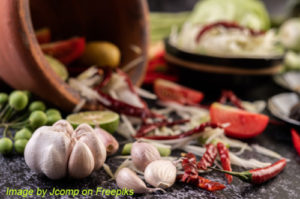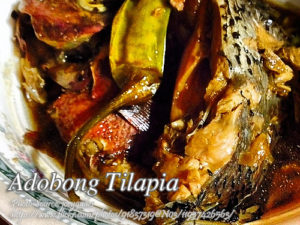Sweet and sour alumahan is one of the many variation of sweet and sour fish. Alumahan or Indian mackerel is not usually cooked as a sweet and sour dish. Most of the time white flesh fish is used like lapu-lapu, cream dory or tilapia.
Alumahan, like galunggong is usually cooked plainly as fried fish or paksiw which is I think is the best dish to serve this fish. But when I tried to cook it as sweet and sour, oh! you will be surprised. This will be your next favorite sweet and sour dish in your next menu!
Sweet and Sour Alumahan: A Rainy Day Discovery
I still remember the first time I tried making sweet and sour alumahan. It was one of those rainy afternoons in Batangas when the sea was rough and the only fresh catch left at the market was alumahan. I stood there debating whether to fry it plain, like my mother always did, or try something new. My Uncle Dodong, who used to work as a cook on a fishing boat, nudged me and said, “Why not make it sweet and sour? Pang-restaurant yan, pero mas masarap pag sa bahay ginawa.” He was right. That simple suggestion turned an ordinary fish into something unexpectedly special.
A Twist on a Filipino Classic
Sweet and sour alumahan is one of those dishes that surprises you in the best way. We’re used to seeing this recipe made with lapu-lapu, cream dory, or tilapia — the usual white fish choices. Alumahan, or Indian mackerel, doesn’t usually get the spotlight. Most of us fry it crisp or simmer it in vinegar for paksiw. But when you use this humble fish for sweet and sour, the result is a balance of flavor and texture that’s hard to beat.
Alumahan has firm, flavorful flesh that holds up beautifully when fried. That’s what makes it perfect for this dish. Once it’s coated in the thick, glossy sauce, it absorbs the sweet, tangy flavors without turning soggy. The contrast between the crispy skin and the sticky sauce is simply addicting.
The Secret Behind the Sauce of Sweet and Sour Alumahan
When my cousin Liza first saw me mixing pineapple syrup, vinegar, ketchup, sugar, and a bit of water in a bowl, she laughed. “Parang halo-halo, Ate!” she said. But that combination is what gives sweet and sour alumahan its trademark flavor — the ideal balance of asim at tamis. The ketchup gives it color and depth, the pineapple syrup adds fruity sweetness, while the vinegar sharpens everything to life.
Here’s a small tip I learned from Uncle Dodong: dissolve the sugar completely before heating the sauce. It helps prevent that gritty texture and makes the glaze smooth and shiny. When you pour it over the fried fish later, it clings perfectly to every piece.
Bringing the Vegetables to Life
Sautéing the ginger first may seem like a small step, but it makes a big difference. The aroma sets the tone for the dish, cutting through the richness of the sauce and fish. I usually add carrots, onions, and bell peppers right after — their colors make the dish come alive. If you have pineapple tidbits, don’t skip them! They bring a subtle burst of sweetness that balances the tang.
As the vegetables soften slightly, I stir in the sweet and sour sauce. Watching the mixture bubble and thicken as it coats the vegetables never fails to make me smile. That’s the moment when you know it’s almost ready.
The cornstarch slurry is another small but crucial trick. It turns the sauce from watery to silky, helping it cling beautifully to the fish. The science behind it is simple: cornstarch molecules expand when heated, thickening the liquid and locking in flavor. That’s why your sauce feels restaurant-quality even in a home kitchen.
The Final Touch
Once the alumahan is fried golden brown, transfer it to a serving plate and pour the sauce and vegetables over the top. The sizzling sound as the sauce hits the crispy skin is music to my ears. I usually serve it right away with steamed rice, though my brother Jun insists it tastes even better with garlic fried rice.
The beauty of sweet and sour alumahan is that it brings a restaurant favorite right to your dining table, using ingredients most Filipino homes already have. It’s an affordable, comforting dish that feels a little fancy — perfect for family lunches or unexpected guests.
A Little Food for Thought
Did you know that the sweet and sour cooking style traces its roots back to Chinese cuisine? Early Chinese settlers in the Philippines brought the technique, and Filipinos adapted it using local ingredients like vinegar and sugar cane. That’s why our version is tangier and more vibrant. Over time, sweet and sour dishes became staples in Filipino celebrations, often served during fiestas and birthdays for good luck — the mix of sweet and sour representing life’s balance of joy and challenge.
So next time you spot alumahan at the market, think beyond frying. Try this sweet and sour version — maybe even put your own twist on it. Who knows? It might become one of your family’s favorite recipes too, just like it did for ours.
Sweet and Sour Alumahan
Ingredients
- 4 pcs Alumahan or Indian mackerel
- 1 Tbsp salt and 1 tsp pepper
- cooking oil for frying and sauteing
Sweet and Sour Ingredients:
- 1 pc bell pepper
- 1 pc onion
- 3 cloves garlic
- 1 pc carrot
- 1 small pouch pineapple tidbits or chunks
- 1 thumbsize ginger
- 1/4 cup vinegar
- 1/4 cup sugar
- 1/3 cup ketchup
- 1/2 cup water
- 1 Tbsp cornstarch
- 1/4 cup water
- Syrup from pineapple tidbits
Instructions
Sweet and Sour Alumahan
- Remove the gills, innards and fins of the Indian mackerel (alumahan). Make a shallow cut on the sides of the fish. Season with salt and pepper.
- Heat cooking oil in a frying pan and fry the fish until golden brown. Remove from pan and transfer to a plate.
- In a bowl, combine pineapple syrup, vinegar, ketchup, sugar and water. Stir until the sugar is dissolved.
- Heat cooking oil in a pan and sauté ginger. Add carrot, onion and bell peppers. Stir for a few minutes.
- Add the sweet and sour mixture and stir for a few seconds. Add pineapple tidbits and season with black pepper.
- Add cornstarch slurry and stir until the sauce becomes thick.
- Put the alumahan in a serving plate and pour the sweet and sour sauce with the veggies on top of the fish. Serve with cooked rice or fried rice.
Video
Notes
Cooking Tips:
Keep the Fish Crispy
After frying the alumahan, let it rest on a wire rack instead of paper towels. This prevents steam from softening the skin and keeps the fish beautifully crisp. Only pour the sweet and sour sauce right before serving so it stays crunchy underneath.Balance the Sweet and Tangy Flavor
The secret to perfect sweet and sour alumahan is finding the right ratio of sugar and vinegar. Too much sugar can make it cloying, while too much vinegar overpowers the dish. Taste your sauce before thickening — you can always adjust it to suit your preference.Make the Sauce Shine
Dissolve the sugar completely in the sauce mixture before heating to achieve a smooth, glossy finish. Stirring constantly while it thickens prevents lumps and ensures an even texture. A little cornstarch slurry goes a long way — add gradually until the sauce coats the back of a spoon.




